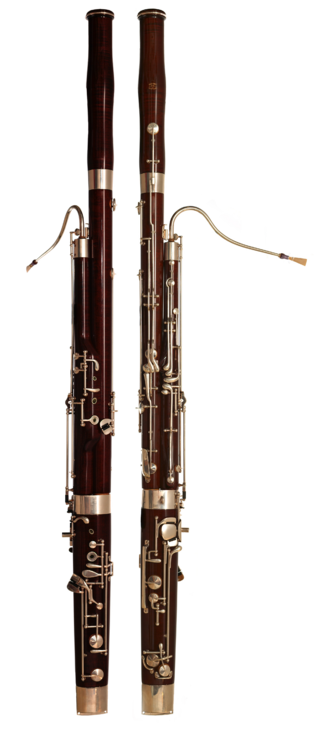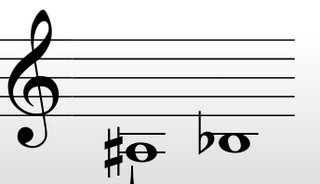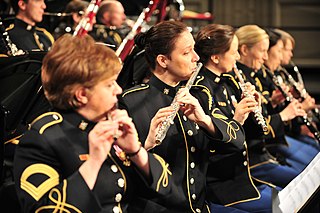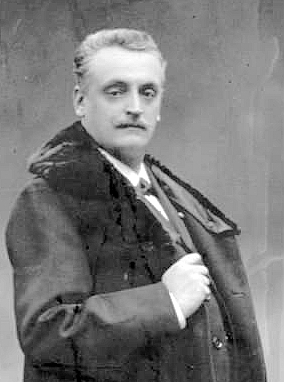
The bassoon is a musical instrument in the woodwind family, which plays in the tenor and bass ranges. It is composed of six pieces, and is usually made of wood. It is known for its distinctive tone color, wide range, versatility, and virtuosity. It is a non-transposing instrument and typically its music is written in the bass and tenor clefs, and sometimes in the treble. There are two forms of modern bassoon: the Buffet and Heckel systems. It is typically played while sitting using a seat strap, but can be played while standing if the player has a harness to hold the instrument. Sound is produced by rolling both lips over the reed and blowing direct air pressure to cause the reed to vibrate. Its fingering system can be quite complex when compared to those of other instruments. Appearing in its modern form in the 19th century, the bassoon figures prominently in orchestral, concert band, and chamber music literature, and is occasionally heard in pop, rock, and jazz settings as well. One who plays a bassoon is called a bassoonist.

The oboe is a type of double-reed woodwind instrument. Oboes are usually made of wood, but may also be made of synthetic materials, such as plastic, resin, or hybrid composites.

The cor anglais, or English horn is a double-reed woodwind instrument in the oboe family. It is approximately one and a half times the length of an oboe, making it essentially an alto oboe in F.
The contrabassoon, also known as the double bassoon, is a larger version of the bassoon, sounding an octave lower. Its technique is similar to its smaller cousin, with a few notable differences.
The heckelphone is a musical instrument invented by Wilhelm Heckel and his sons. The idea to create the instrument was initiated by Richard Wagner, who suggested its concept at the occasion of a visit of Wilhelm Heckel in 1879. Introduced in 1904, it is similar to the oboe but, like the bass oboe, pitched an octave lower, the heckelphone having a significantly larger bore.
The oboe d'amore (Italian for 'love oboe';, less commonly hautbois d'amour, is a double reed woodwind musical instrument in the oboe family. Slightly larger than the oboe, it has a less assertive and a more tranquil and serene tone, and is considered the mezzo-soprano of the oboe family, between the oboe and the cor anglais or English horn. It is a transposing instrument, sounding a minor third lower than it is notated, i.e. in A. The bell is pear-shaped and the instrument uses a bocal, similar to but shorter than that of the cor anglais.
Walter Sinclair Hartley was an American composer of contemporary classical music.

The Concerto in D major for Oboe and Small Orchestra, AV 144, TrV 292, was written by Richard Strauss in 1945. It was one of the last works he composed near the end of his life, during what is often described by biographers, journalists and music critics as his "Indian summer."
In music, a nonet is a chamber music composition which requires nine musicians for a performance. The standard nonet scoring is for wind quintet, violin, viola, cello, and double bass, though other combinations are also found. Additionally, the term may apply to a group of nine musicians regardless of whether they are playing chamber music.

The contrabass oboe is a double reed woodwind instrument in the key of F, sounding an octave and a fifth lower than the standard oboe.
Baritone is a type of classical male singing voice whose vocal range lies between the bass and the tenor voice type
Reed aerophones is one of the categories of musical instruments found in the Hornbostel-Sachs system of musical instrument classification. In order to produce sound with these Aerophones the player's breath is directed against a lamella or pair of lamellae which periodically interrupt the airflow and cause the air to be set in motion.
An oboe quintet is a chamber music group of five individuals led by an oboist, or music written for this ensemble.
In music, a duodecet—sometimes duodectet, or duodecimette—is a composition which requires twelve musicians for a performance, or a musical group that consists of twelve people. In jazz, such a group of twelve players is sometimes called a "twelvetet". The corresponding German word is Duodezett. The French equivalent form, douzetuor, is virtually unknown. Unlike some other musical ensembles such as the string quartet, there is no established or standard set of instruments in a duodecet.

The woodwind section, which consists of woodwind instruments, is one of the main sections of an orchestra or concert band. Woodwind sections contain instruments given Hornbostel-Sachs classifications of 421 and 422, but exclude 423

Georges-Vital-Victor Gillet was a French oboist, teacher and composer. In addition to premiering oboe works by prominent French composers of the 19th century, including Émile Paladilhe, Charles-Édouard Lefebvre, Clémence de Grandval, and Camille Saint-Saëns, among others, Gillet was the teacher of Fernand Gillet and Marcel Tabuteau at the Paris Conservatory, helped develop the F. Lorée brand of oboe, and composed a number of études that are still used today.
The Concerto for Oboe and Orchestra is a composition for oboe solo and orchestra by the American composer Ellen Taaffe Zwilich. The work was commissioned by the Cleveland Orchestra in honor of their principal oboist John Mack's 25th year with the orchestra. It was first performed by Mack and the Cleveland Orchestra under the direction of Christoph von Dohnányi on January 17, 1991. The piece is dedicated "with affection" to John Mack.







